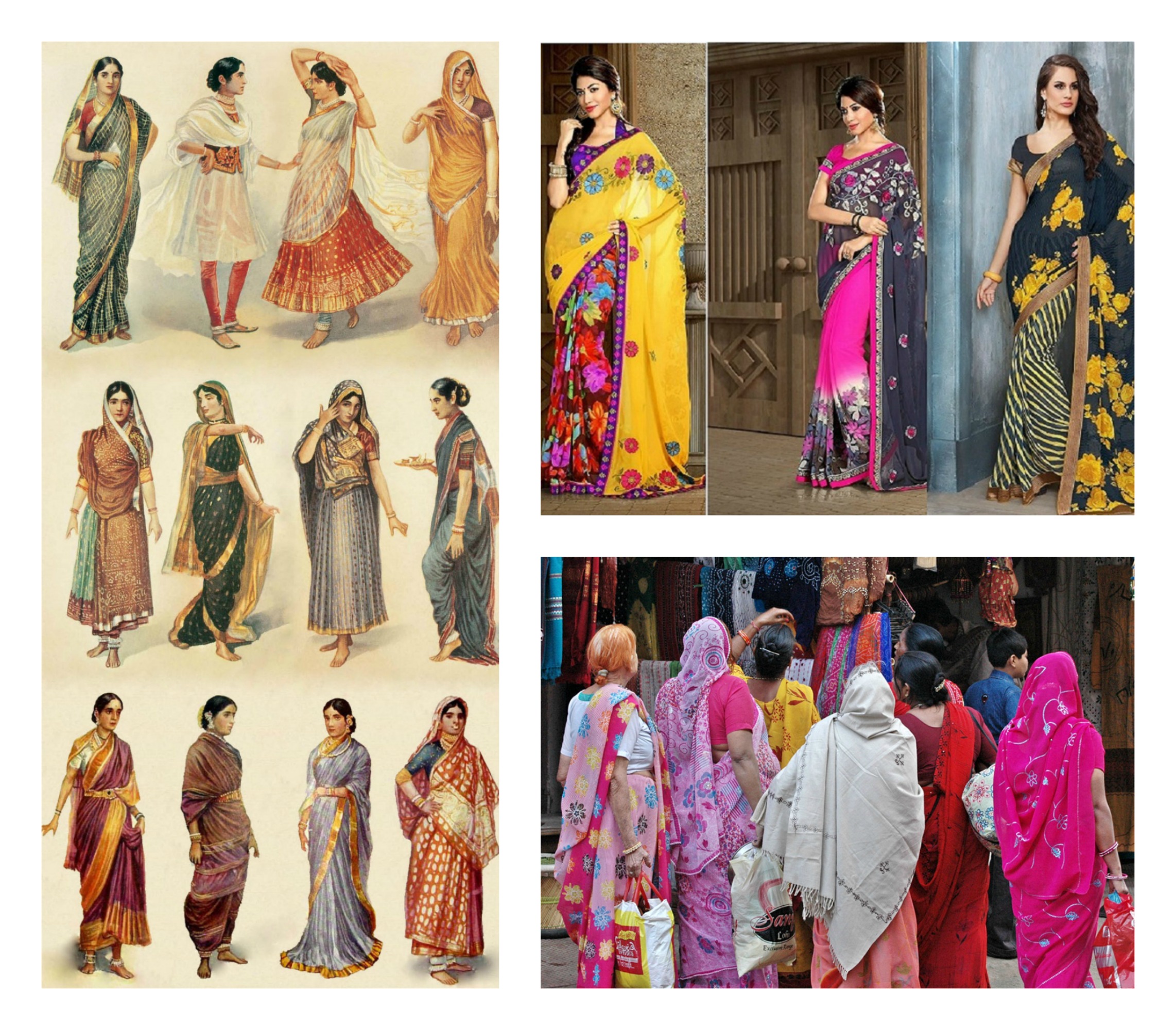Sari is the most popular women attire in South Asia. The Hindi word Sari is a Pali version of the Sanskrit word Sati, which means ‘Strip of cloth’. Ancient Indian Sanskrit texts and Buddhist literature Jatakas have mentioned the word Satika (शाटिका) describing the women’s attire. It is believed that Helen the daughter of Seleucus who was married to Chandragupta Maurya, made sari popular women attire among the masses.
Sari Draping Styles –
A sari is an unstitched drape with varying lengths between 15-30 feet and width between 2-4 feet. The sari can be draped in several different styles. However, some styles do require a sari of a particular length or form. Following are some of the common sari draping styles.
- Gujarati / Rajasthani – The pleats are neatly spread over the front so that the pallu design is seen.
- Bengali / Odia – The loose end is considerably longer and goes around the body over the left shoulder. Thus, there is enough cloth left to cover the head also.
- Nivi Sari – The pleats are passed through the legs and tucked into the waist at the back allowing free movement while covering the legs.
- Nav-vari – This drape is common in Maharashtra. It is similar to that of the male wearing dhoti.
- Himalayan (Kulluvi Pattu) – This is the traditional form of woollen sari worn in Himachal Pradesh and Uttaranchal.
- Madisar – This style is very popular among Iyengar/Iyer Brahmin ladies from Tamil Nadu.
- Gobbe Seere – This style is commonly worn in the Sahyadri and central region of Karnataka.
- Kodagu – The pleats are created in the rear, instead of the front. The loose end of the sari is draped back-to-front over the right shoulder and is pinned to the rest of the sari. This is not common outside the Kodagu district of Karnataka.
- Kerala sari – The two-piece sari made of unbleached cotton and decorated with gold or coloured stripes and/or borders, worn in Kerala.
Sari Styles – Handloom sari weaving is one of India’s cottage industries and in each region, the weavers have specialised processes of dyeing, warping, sizing, attaching the warp, weft winding and weaving etc. Thus, many regional sari styles have evolved in due course. These styles are based on fabric, print, design and length etc.
Eastern India Sari Styles –
- Bengal – Taant, Kaantha, Korial, Baluchari, Jamdani, Shantiuri, Dhakai Katan and Rajshahi
- Assam – Moonga silk, Patt silk and Mekhla
- Manipur – Manipuri Taant and Moirang
- Odisha – Sambalpuri silk, Ikkat silk, Pasapali, Berhampuri, Bapta silk, Sonepuri silk, Khandua silk, Bomkai, Mattha silk, Kotpad Pata, Tanta and Kotki
Western India Sari Styles –
- Rajasthan – Bandhani, Bagru and Kota Doria
- Gujarat – Bandhani and Patola
- Maharashtra – Yeola, Peshwai Shalu, Paithanpattu, Narayanpeth, Khun fabric, Mahalsa, Lugade and Karvati Tussar
North and Central India Sari styles –
- Uttar Pradesh – Banarasi, Shalu and Tanchoi
- Himachal Pradesh – Pattu
- Madhya Pradesh – Dhokra silk, Maheshwari and Chanderi
- Chhattisgarh – Kosa silk
South India Sari Styles –
- Andhra – Venkatagiri, Chirala, Uppada silk, Mangalagiri, Bandar, Bandarulanka, Kupaddam and Dharmavaram
- Telangana – Pochampally, Gadwal and Narayanpet
- Karnataka –Ilkal, Molakalmuru, Sulebhavi and Mysore silk
- Kerala – Balarampuram, Kannur cotton, Kalpathi silk, Maradka silk, Mundum Neriyathum, Mayilati silk , Kasargod, Kerala silk and Samudrikapuram silk
- Tamil Nadu – Kanchipuram, Chettinad, Arani silk, Kumbakonam, Thirubuvanam, Coimbatore cotton, Salem silk, Sungudi, Arni silk, Koorai, Kandangi, Rasipuram silk, Chennai, Kuraikudi, Madurai cotton, Tiruchirapalli, Thoothukudi, Nagarcoil and Thanjavur
